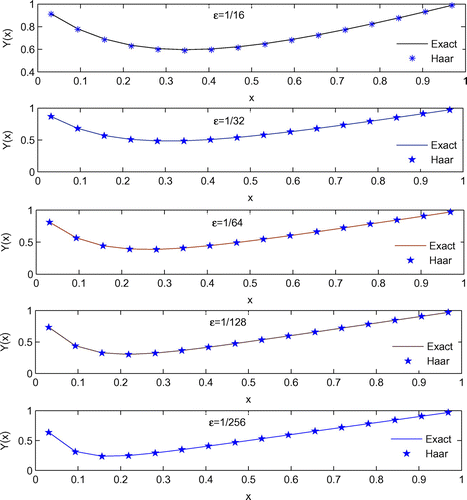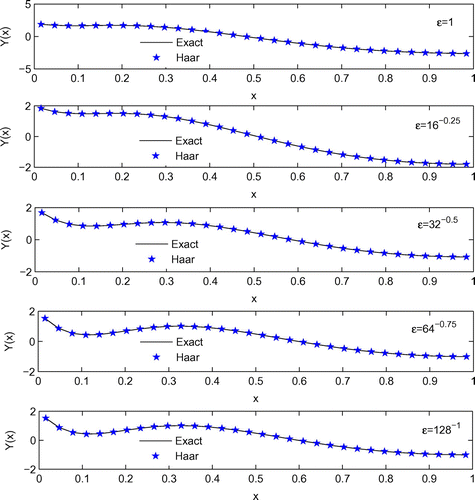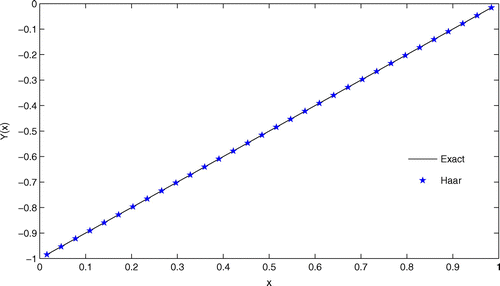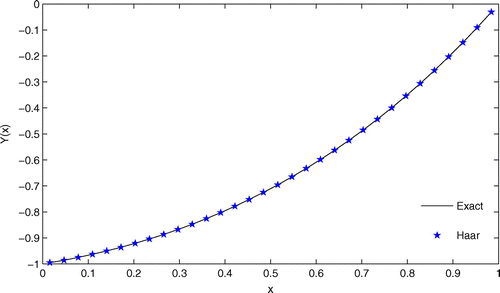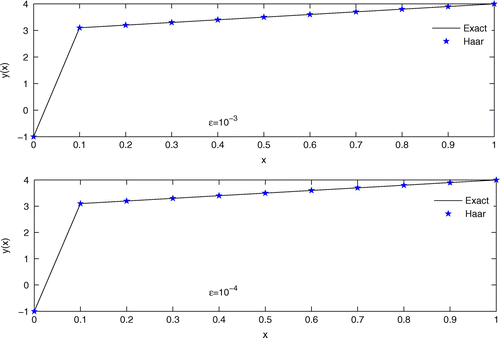 ?Mathematical formulae have been encoded as MathML and are displayed in this HTML version using MathJax in order to improve their display. Uncheck the box to turn MathJax off. This feature requires Javascript. Click on a formula to zoom.
?Mathematical formulae have been encoded as MathML and are displayed in this HTML version using MathJax in order to improve their display. Uncheck the box to turn MathJax off. This feature requires Javascript. Click on a formula to zoom.Abstract
In this paper, a collocation method based on Haar wavelets is proposed for the numerical solutions of singularly perturbed boundary value problems. The properties of the Haar wavelet expansions together with operational matrix of integration are utilized to convert the problems into systems of algebraic equations with unknown coefficients. To demonstrate the effectiveness and efficiency of the method various benchmark problems are implemented and the comparisons are given with other methods existing in the recent literature. The demonstrated results confirm that the proposed method is considerably efficient, accurate, simple, and computationally attractive.
Public Interest Statement
Singular perturbation problems (SPPs) have applications in various disciplines of knowledge, for instance, neurobiology, fluid mechanics, elasticity, quantum mechanics, geophysics, aerodynamics, oceanography, chemical reactor theory, convection–diffusion processes, and optimal control. It is a well-known fact that the solution of these problems exhibit multi-scale character so the usual numerical treatment of SPPs gives major computational difficulties due to the presence of boundary and interior layers and, in recent years, a large number of numerical methods have been developed to provide accurate numerical solutions. In this work, a new collocation method based on Haar wavelets is proposed for the numerical solution of singularly perturbed two-point boundary value problems. Accuracy and efficiency of the suggested method is established through comparison with the existing methods available in the open literature.
1. Introduction
Singularly perturbed problems (SPPs) arise in various branches of applied mathematics and physics such as fluid mechanics, quantum mechanics, elasticity, plasticity, semi-conductor device physics, geophysics, optimal control theory, aerodynamics, oceanography, and mathematical models of chemical reactions. Mathematically, self-adjoint SPPs are defined as(2.1)
(2.1)
where are given constants,
is a small positive parameter such that
and f(x), g(x) are sufficiently smooth functions. It is known that Problem (1.1) has a unique solution y, which in general displays boundary layers at
and
. These type of problems are characterized by the presence of a small parameter
that multiplies the highest order derivative, and they are stiff and there exists a boundary or interior layer where the solutions change rapidly. That is, there are thin transition layers where the solution varies rapidly or jumps abruptly, while away from the layers the solution behaves regularly and varies slowly. For more details on singular perturbation problems, we refer to the monographs (Miller, O’Riordan, & Shishkin, Citation1996; Roos, Stynes, & Tobiska, Citation1996).
In recent years, the studies of SPPs problems have been tackled by many researchers but the majority of these problems cannot be solved analytically, so one would like ideally to use the numerical methods available in the open literature such as homotopy perturbation method (Chun & Sakthivel, Citation2010), Adomian decomposition method (Wazwaz, Citation2002), sinc approximation solution (Mohsen & EL-Gamel, Citation2008), spline collocation method (Aziz & Khan, Citation2002; Kadalbajoo & Arora, Citation2010; Kadalbajoo & Gupta, Citation2009; Kadalbajoo, Gupta, & Awasthi, Citation2008; Khan, Khan, & Aziz, Citation2006; Khan & Khandelwala, Citation2014; Kumar & Mehra, Citation2007; Rashidinia, Ghasemi, & Mahmoodi, Citation2007; Surla & Stojanovic, Citation1988), reproducing kernel method (Geng & Cui, Citation2011), finite element method (Lenferink, Citation2002), the finite-volume element method (Phongthanapanich & Dechaumphai, Citation2009), and wavelet method (Pandit & Kumar, Citation2014). An alternative solution is proposed in the present paper in the form of operational matrix method, which is based on Haar wavelets for the numerical solution of singularly perturbed reaction–diffusion problems.
Wavelets became an active field of research in the 1980s, with the works of researchers such as Morlet, Grossman, and Daubechies (Citation1992) on signal processing. Starting as an alternative to Fourier analysis, their popularity soon expanded, owing mainly to the localized nature of wavelet basis in frequency and time, as well as their hierarchical structure. Wavelets have numerous applications in approximation theory and have been extensively used in the context of numerical approximation in the relevant literature during the last two decades. Different types of wavelets and approximating functions have been used in numerical solution of boundary value problems such as Daubechies, Battle–Lemarie, B-spline, Chebyshev, Legendre, and Haar wavelets. Among all the wavelet families, the Haar wavelets have gained popularity among researchers due to their useful properties such as simple applicability, orthogonality, and compact support. Compact support of the Haar wavelet basis permits straight inclusion of the different types of boundary conditions in the numeric algorithms. The basic idea of Haar wavelet method is to convert the differential equations to a system of algebraic equations by the operational matrices of integral or derivative (Chen & Hsiao, Citation1997; Lepik, Citation2008). Recently, many authors have used Haar wavelet method for solving ordinary and partial differential equations. For a historical background and an overview of wavelets in general and Haar wavelets in particular, the reader can refer to Lepik (Citation2014).
The objective of this research is to construct a simple collocation method based on Haar wavelets for the numerical solution of singularly perturbed reaction–diffusion problems of the type (1.1) which arise in mathematical modeling of different engineering applications. The proposed method has the following advantages in comparison to the existing methods available in the open literature:
| (1) | Haar wavelets collocation method (HWCM) uses simple box functions and consequently the formulation of numerical method based on these functions involves lesser manual labor. | ||||
| (2) | HWCM does not require to calculate the inverse of Haar wavelet matrix. | ||||
| (3) | Contrary to reproducing kernel method (RKM), HWCM performs very well for a boundary value problem defined on a very long interval. | ||||
| (4) | Unlike RKM, HWCM does not require conversion of a boundary value problem into initial value problem using a procedure like shooting and hence this method eliminates the possibility of unstable solution due to missing initial condition in the case of RKM. | ||||
| (5) | Contrary to RKM, the boundary value problem needs not to be reduced into a system of first-order ODE’s. | ||||
| (6) | A variety of boundary conditions can be handled with equal ease. | ||||
Table 1. Maximum absolute errors for different values of N and
The organization of this paper is as follows. In Section 2, Haar wavelets and their integral are introduced. In Section 3, the Haar wavelet collocation method is presented and described for the numerical solution of the class of singularly perturbed reaction–diffusion equations. In Section 4, our method has been tested by several problems and the obtained results are compared with results of the existing methods. Finally, in Section 5, the conclusion of the study is given.
2. Haar wavelets and operational matrix of integration
Haar wavelets have been used from 1910 when they were introduced by the Hungarian mathematician Alfred Haar (Lepik, Citation2014). The Haar wavelet, being an odd rectangular pulse pair, is the simplest and the oldest orthonormal wavelet with compact support. The Haar wavelet family for is defined as follows:
(3.1)
(3.1)
where
Here, m and k have integer values as and J show the resolution of the wavelet and
is the translation parameter. Maximal level of resolution is J. The index of
in Equation (2.1) is calculated by
. In the case with minimal values
, we have
, the maximal value of i is
. We also have
corresponding to the scaling function of Haar wavelet family, i.e.
in [0, 1]. For more about Haar wavelets and their applications, we refer to the monographs (Debnath & Shah, Citation2015; Lepik, Citation2014).
Next, we shall establish an operational matrix for integration by means of Haar wavelets for which we follow the same notations as used in Lepik (Citation2008) for Haar function and their integrals as follows:(3.2)
(3.2)
These integrals can be calculated analytically with the help of Equation (2.1); by doing so we get the following equations(3.3)
(3.3)
where and
. Note that
Table 2. Maximum absolute errors for different values of N and
Any square integrable function y(x) defined on [0, 1] can be expressed in term of the Haar basis as follows:(3.4)
(3.4)
where the Haar coefficients , are determined by
(3.5)
(3.5)
Table 3. Maximum absolute errors for different values of N and
Even though the series expansion of y(x) involves infinite terms, if y(x) is a piecewise constant or it may be approximated as a piecewise constant for each sub-interval, then y(x) can be terminated at finite terms. That means y(x) can be expressed as follows:(3.6)
(3.6)
Equivalently, above relation can be written in the matrix form as follows:(3.7)
(3.7)
where is the discrete form of the continuous function y(x) and
is the m-dimensional row vector. Moreover,
is the Haar wavelet matrix of order m and is defined by
; that is,
(3.8)
(3.8)
where are the discrete form of the Haar wavelet basis. For Haar wavelet approximations, the following collocation points are considered:
(3.9)
(3.9)
Table 4. Maximum absolute errors for different values of N and
For example, if , so that the Haar matrix can be expressed as follows:
At the collocation points as defined by (2.9), equation (2.6) becomes(3.10)
(3.10)
The Haar approximation of y is given by
(3.11)
(3.11)
Therefore, the corresponding error at the mth level may be defined as follows:
3. Method of solution
With the aid of Haar operational matrices as defined in Section 2, we solve the following singularly perturbed reaction–diffusion problem of the form(4.1)
(4.1)
where f(x), g(x) are real-valued sufficiently smooth functions in [0, 1]. Let us assume that(4.2)
(4.2)
where ’s,
are Haar coefficients to be determined. Integrating Equation (3.2) from 0 to x together with the given initial condition, we obtain
(4.3)
(4.3)
Table 5. Numerical result of Example 4.5 at and
Again integrating Equation (3.3) with the initial condition, then we have(4.4)
(4.4)
To calculate , we integrate Equation (3.3) between the limits 0 to 1 to get
(4.5)
(4.5)
Hence, Equation (3.4) becomes(4.6)
(4.6)
Table 6. Maximum absolute errors of Example 4.6 for different values of and N
Substituting the values of and y(x) in Equation (3.1) and the discretization is applied using the collocation points given by (2.9) resulting into a system of algebraic equations which contains unknowns vectors
’s. Solving this system of algebraic equations using the classical Newton’s method, we obtain the Haar wavelet coefficients
’s and then substituting these values in (3.4), we obtain the Haar wavelet collocation method for the numerical solution of singularly perturbed boundary value problem of the type (1.1).
4. Numerical experiments and discussion
In this section, we are going to study numerically the SPPs (3.1) with the known boundary condition. The main aim here is to show the accuracy and applicability of the present method, described in Section 3, for solving the SPPs. Performance of the proposed method is compared with the existing methods in literature (Khan et al., Citation2014; Kumar, Singh, & Mishra, Citation2007; Lubuma & Patidar, Citation2006; Natesan, Kumar, & Vigo-Aguiar, Citation2003; O’Riordan & Stynes, Citation1986; Rashidinia et al., Citation2007; Schatz & Wahlbin, lab26 ). The numerical results infer that the proposed method is very effective and superior in comparison with other existing methods. Numerical computations have been done with the software package MATLAB 7.0 and graphical outputs were generated by MAPLE 14 package.
Example 4.1
Consider the following singularly perturbed boundary value problem (Khan et al., Citation2014; Rashidinia et al., Citation2007):(5.1)
(5.1)
The exact solution of this problem is(5.2)
(5.2)
The obtained maximum absolute errors of (4.1) is presented in comparison with the existing methods and exact solution (4.2) in Table for different values of and N. From Table , it is clear that HWCM performs much better than existing methods (Khan et al., Citation2014; Rashidinia et al., Citation2007). Table also shows improved convergence of HWCM, as with the increase in number of collocation points the maximum absolute errors decrease for the solution. The numerical result for
and different values of
is shown in Figure .
Example 4.2
Let us consider the following singular perturbation problem (Lubuma et al., Citation2006; O’Riordan et al., Citation1986):(5.3)
(5.3)
where
The exact solution of the above problem is
Table gives the maximum absolute error for test Example 4.2. It is obvious that the error bound is inversely proportional to the level of resolution J of Haar wavelet. Hence, the accuracy in the proposed method (HWCM) improves as we increase the level of resolution J. The solution produced through HWCM for the singularly perturbed boundary value problem (4.3) is shown in Figure for different values of and
.
Example 4.3
We next consider the singularly perturbed problem (Schatz et al., Citation1983)(5.4)
(5.4)
whose exact solution is given by
We solve this problem by HWCM method which developed in Section 2 and compare our numerical results with finite element method (Schatz et al., lab26). In this example, the computed maximum absolute errors are compared with the exact solution at specified points in reference (Schatz et al., lab26) and the results are shown in Table and graphically shown in Figure . This table shows that our method is considerably accurate in comparison with method in (Schatz et al., Citation1983).
Example 4.4
Consider the following singular perturbed problem(5.5)
(5.5)
The exact solution of the above problem is
Next, we consider a nonlinear singular perturbation problem with left-end boundary layer. First, we convert the underlying problem as a sequence of linear singular perturbation problem using Newton’s quasi-linearization technique, i.e. replacing the nonlinear problem by a sequence of linear problems. Then, the outer solution (the solution of the given problem by putting ) is taken to be the initial approximation (Table and graphically shown in Figure ).
Example 4.5
We consider the following nonlinear singular perturbation problem (Kadalbajoo et al., Citation2010; Kumar, Singh, & Mishra, Citation2007)(5.6)
(5.6)
with and
. The exact solution of the problem is
(5.7)
(5.7)
where and
For convenience, we convert the nonlinear Equation (4.6) into linear by taking the initial approximation from the problem . For
, we assume that
, and
. Further, in order to satisfy the condition at
, we take
so as a result, we obtain the linear version of (4.6) as follows:
(5.8)
(5.8)
with and
. The numerical results of Example 4.5 are presented in Table and graphically shown in Figure for
and
.
Example 4.6
Finally, consider the following singularly perturbed turning point problem (Natesan et al., Citation2003):(5.9)
(5.9)
with and
. The exact solution of the above problem is
(5.10)
(5.10)
Table gives the maximum absolute error for test Example 4.6. It is obvious that the error bound is inversely proportional to the level of resolution J of Haar wavelet. Hence, the accuracy in the proposed method (HWCM) improves as we increase the level of resolution J. It further strengthens the claim that the proposed method gives excellent results even for very small .
5. Conclusion
The Haar wavelet collocation method is applied in order to find the numerical solution of one-dimensional singularly perturbed boundary value problems. The method is tested on several benchmark problems from the literature. The numerical results are compared with a few existing methods reported recently in the literature. The numerical evidence shows superiority of the new method in terms of fast convergence and better accuracy. The proposed method can safely and quickly be used for the solution of a wide range of similar problems.
Additional information
Funding
Notes on contributors
Firdous A. Shah
Firdous A. Shah is a senior assistant professor in the Department of Mathematics at the University of Kashmir, India. His primary research interests include basic theory of wavelets and their applications in differential and integral equations, Economics and Finance, and Computer Networking. He has authored/co-authored over 60 research papers in international journals of high repute. He has recently co-authored a book on wavelets entitled Wavelet Transforms and Their Applications, Springer, New York, 2015. Rustam Abass received his MSc in Applied Mathematics from BGSB University Rajouri, India. His research interests are focused on different wavelet methods for the numerical treatment of integral and differential equations. Javid Iqbal received his MPhil and PhD degrees in Mathematics from Aligarh Muslim University, Aligarh, India. Currently, he is a senior assistant professor in the Department of Mathematical Sciences, BGSB University, Rajouri.
R. Abass
R. Abass received his MSc in Applied Mathematics from BGSB University Rajouri, India. His research interests are focused on different wavelet methods for the numerical treatment of integral and differential equations.
J. Iqbal
J. Iqbal received his MPhil and PhD degrees in Mathematics from Aligarh Muslim University, Aligarh, India. Currently, he is a senior assistant professor in the Department of Mathematical Sciences, BGSB University, Rajouri.
References
- Aziz, T., & Khan, A. (2002). A spline method for second-order singularly perturbed boundary-value problems. The Journal of Computational and Applied Mathematics, 147, 445–452.
- Chen, C. F., & Hsiao, C. H. (1997). Haar wavelet method for solving lumped and distributed-parameter systems. IEE Proceedings - Control Theory and Applications, 144, 87–94.
- Chun, C., & Sakthivel, R. (2010). Homotopy perturbation technique for solving two-point boundary value problems-comparison with other methods. Computer Physics Communications, 181, 1021–1024.
- Daubechies, I. (1992). Ten lectures on wavelets. Philadelphia, PA: SIAM.
- Debnath, L., & Shah, F. A. (2015). Wavelet transforms and their applications. New York, NY: Birkhäuser.
- Geng, F. Z., & Cui, M. G. (2011). A novel method for solving a class of singularly perturbed boundary value problems based on reproducing kernel method. Applied Mathematics and Computation, 218, 4211–4215.
- Kadalbajoo, M. K., & Arora, P. (2010). B-splines with artificial viscosity for solving singularly perturbed boundary value problems. Mathematical and Computer Modelling, 52, 654–666.
- Kadalbajoo, M. K., & Gupta, V. (2009). Numerical solution of singularly perturbed convection-diffusion problem using parameter uniform B-spline collocation method. The Journal of Mathematical Analysis and Applications, 355, 439–452.
- Kadalbajoo, M. K., Gupta, V., & Awasthi, A. (2008). A uniformly convergent B-spline collocation method on a nonuniform mesh for singularly perturbed one-dimensional time-dependent linear convection-diffusion problem. The Journal of Computational and Applied Mathematics, 220, 271–289.
- Khan, A., Khan, I., & Aziz, T. (2006). Sextic spline solution of singularly perturbed boundary-value problems. Applied Mathematics and Computation, 181, 432–439.
- Khan, A., & Khandelwala, P. (2014). Non-polynomial sextic spline solution of singularly perturbed boundary-value problems. International Journal of Computer Mathematics, 91, 1122–1135.
- Kumar, V., & Mehra, M. (2007). Cubic spline adaptive wavelet scheme to solve singularly perturbed reaction diffusion problems. International Journal of Wavelets, Multiresolution and Information Processing, 5, 317–331.
- Kumar, M., Singh, P., & Mishra, H. K. (2007). An initial-value technique for singularly perturbed boundary value problems via cubic spline. International Journal for Computational Methods in Engineering Science and Mechanics., 8, 419–427.
- Lenferink, W. (2002). A second order scheme for a time-dependent, singularly perturbed convection-diffusion equation. The Journal of Computational and Applied Mathematics, 143, 49–68.
- Lepik, U., & Hein, H. (2014). Haar wavelets with applications. New York, NY: Springer.
- Lepik, U. (2008). Solving integral and differential equations by the aid of nonuniform Haar wavelets. Applied Mathematics and Computation, 198, 326–332.
- Lubuma, J. S., & Patidar, K. C. (2006). Uniformly convergent non-standard finite difference methods for self-adjoint singular perturbation problems. The Journal of Computational and Applied Mathematics, 191, 228–238.
- Miller, J. H., O’Riordan, E., & Shishkin, G. I. (1996). Fitted numerical methods for singular perturbation problems. Singapore: World Scientific.
- Mohsen, A., & EL-Gamel, M., (2008). On the Galerkin and collocation methods for two-point boundary value problem using Sinc bases. International Journal of Computer Mathematics, 56, 930–941.
- Natesan, S., Kumar, J. J., & Vigo-Aguiar, J. (2003). Parameter uniform numerical method for singularly perturbed turning point problems exhibiting boundary layers. The Journal of Computational and Applied Mathematics, 158, 121–134.
- O’Riordan, E., & Stynes, M. (1986). A uniformly accurate finite-element method for a singularly perturbed one-dimensional reaction-diffusion problem. Mathematics of Computation, 47, 555–570.
- Pandit, S., & Kumar, M. (2014). Haar wavelet approach for numerical solution of two parameters singularly perturbed boundary value problems. Applied Mathematics & Information Sciences, 8, 2965–2974.
- Phongthanapanich, S., & Dechaumphai, P. (2009). Combined finite volume element method for singularly perturbed reaction-diffusion problems. Applied Mathematics and Computation, 209, 177–185.
- Rashidinia, J., Ghasemi, M., & Mahmoodi, Z. (2007). Spline approach to the solution of a singularly-perturbed boundary-value problems. Applied Mathematics and Computation, 189, 72–78.
- Roos, H. G., Stynes, M., & Tobiska, L. (1996). Numerical Methods for singularly perturbed differential equations. New York, NY: Springer.
- Schatz, A. H., & Wahlbin, L. B. (1983). On the finite element method for singularly perturbed reaction-diffusion problems in two and one dimensions. Mathematics of Computation, 40, 47–89.
- Surla, K., & Stojanovic, M. (1988). Solving singularly-perturbed boundary-value problems by splines in tension. The Journal of Computational and Applied Mathematics, 24, 355–363.
- Wazwaz, A. M. (2002). A new method for solving singular initial value problems in the second-order ordinary differential equations. Applied Mathematics and Computation, 128, 45–57.

